Gigabyte Aorus FO48U 48" 4K OLED Review - grahamthein2000
Today we'rhenium checking out the Aorus FO48U, the in style Organic light-emitting diode monitor from Gigabyte... or should we aver Telly?
It's 48 inches in size, which hardly counts atomic number 3 a normal Monitor, but is also a shade small for a modern TV. Some other way to describe this, it's simply a wide-ranging gaming display with a 4K resolution, 120Hz refresh rate and OLED technology for that sweet, sweet HDR goodness.
The Aorus FO48U is a specially interesting show because it uses the same panel as the highly regarded LG C1 OLED that we reviewed few months back. We looked at how the LG C1 performed as a computer monitor and while that's not its abstract apply case, it's a very impressive content consumption show that's great for gambling. The FO48U offers an alternative to LG's model, with a few Thomas More PC specific features.
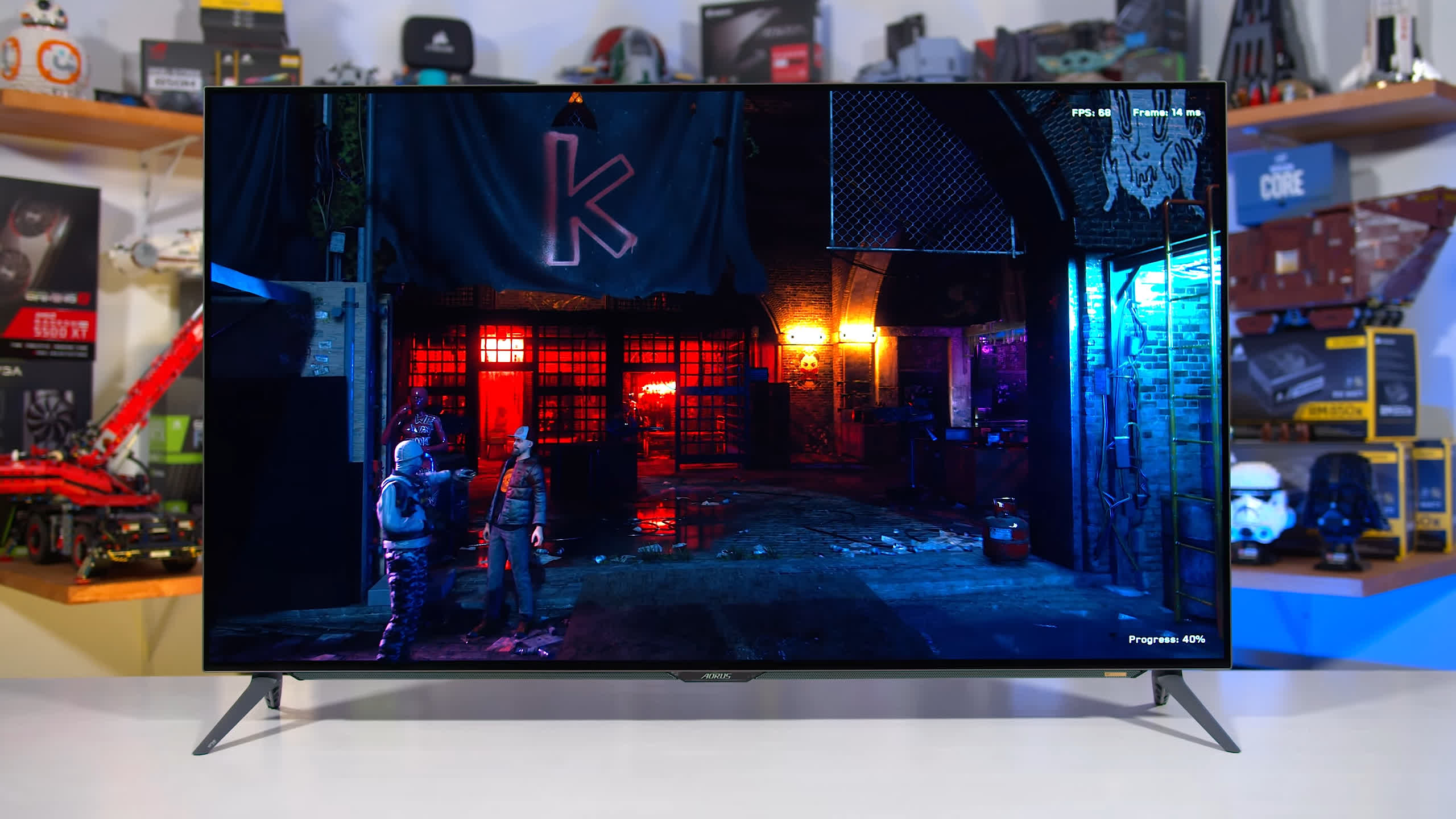
The big one is the addition of DisplayPort, which makes it more compatible with today's artwork cards. The LG C1 requires HDMI 2.1 for 120Hz operation, so that restricts it to RTX 3000 and RX 6000 serial publication GPUs, as well every bit current generation consoles.
The Aorus FO48U supporting DisplayPort 1.4 with DSC makes it easier to use with early-gen GPUs that support that tech, but didn't closing up getting HDMI 2.1, like Nvidia's RTX 20 series.
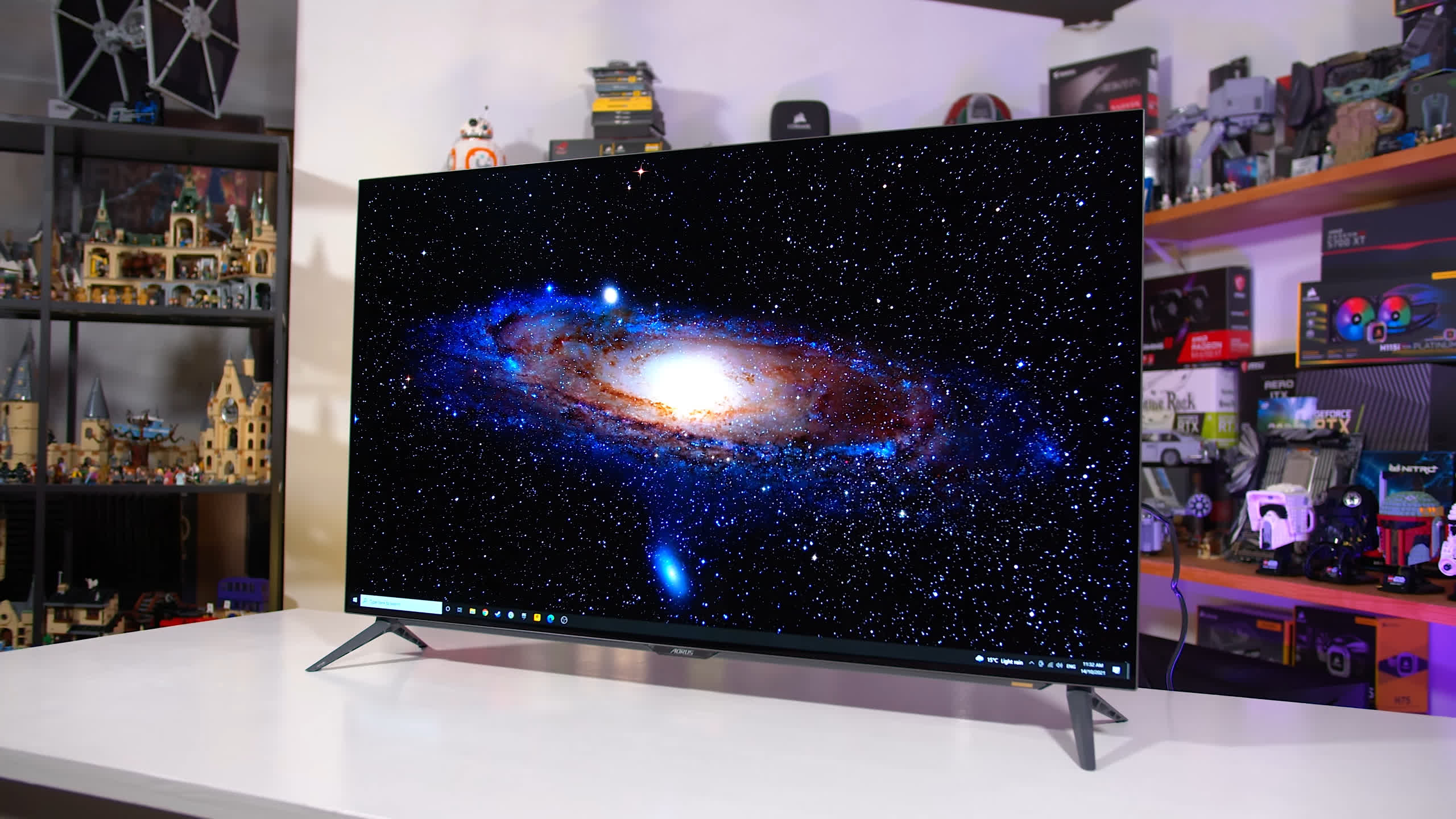
Gigabyte also offers KVM shift functionality, allowing you to use a single keyboard and sneak away with double input devices, a neat addition that's becoming standard crossways the company's batting order. The OSD is actually very confusable to other GB monitors, so other features like their dashboard and chicane crosshairs are too in that respect.
With Gigabyte taking a bigger pore on monitor functionality with their 48-inch OLED, this means at that place are no TV features at all. The LG C1 comes with a full set chic Television receiver options and app suffer, interesting image processing features like AI upscaling and noise reduction, and a TV tuner. The FO48U has none of that -- some might prefer not to have any net connected features on their Telly and just want it to be a dumb display, but there's No sceptical the feature list suffers every bit a result.
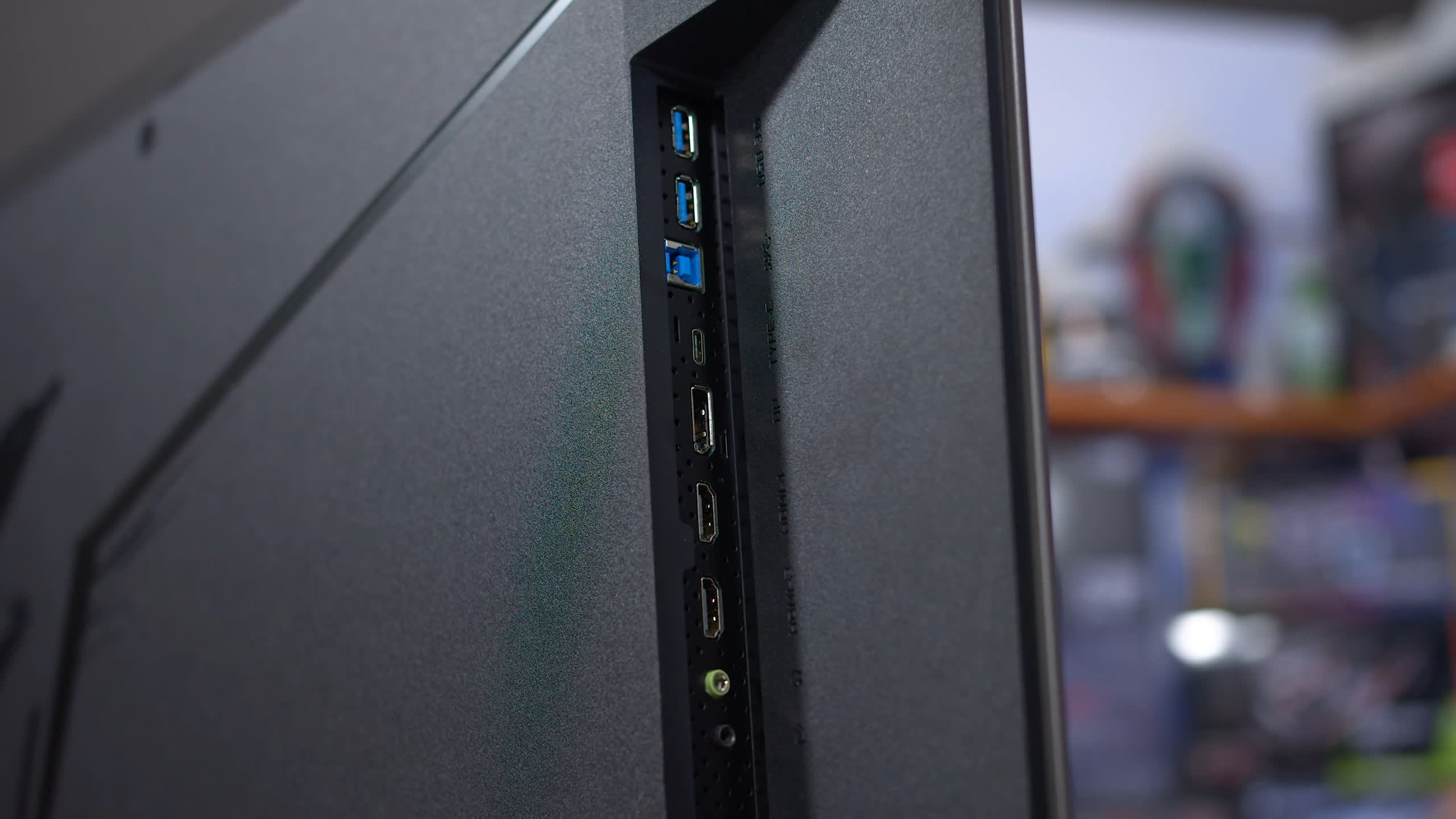
The FO48U also takes a rearwards step on HDMI inputs. Yes, we suffice capture DisplayPort, but on that point's just two HDMI 2.1 ports alternatively of four on the LG C1, and the HDMI 2.1 ports are minor to just 24 Gbps. This means to achieve 120Hz at 4K it needs DSC over HDMI, which causes limits for some devices like the PlayStation 5. That's a tur of a run out, not to offer the full 48Gbps regrettably.
Designing and Features
It damage of how it looks, this is very much a TV, with zero engineering adjustment possible as the display is held up by two short, geosynchronous leg stands. The build quality is good overall, with an expansive glass panel on the front, all-metal legs, and sane utilize of plastic and metallic element connected the rear.
Alike the LG, the top plane section of the display is very thin to highlight the thinness of OLED, though this balloons call at the middle and as to agree the components. The inputs are every last set on the left slope of the display.
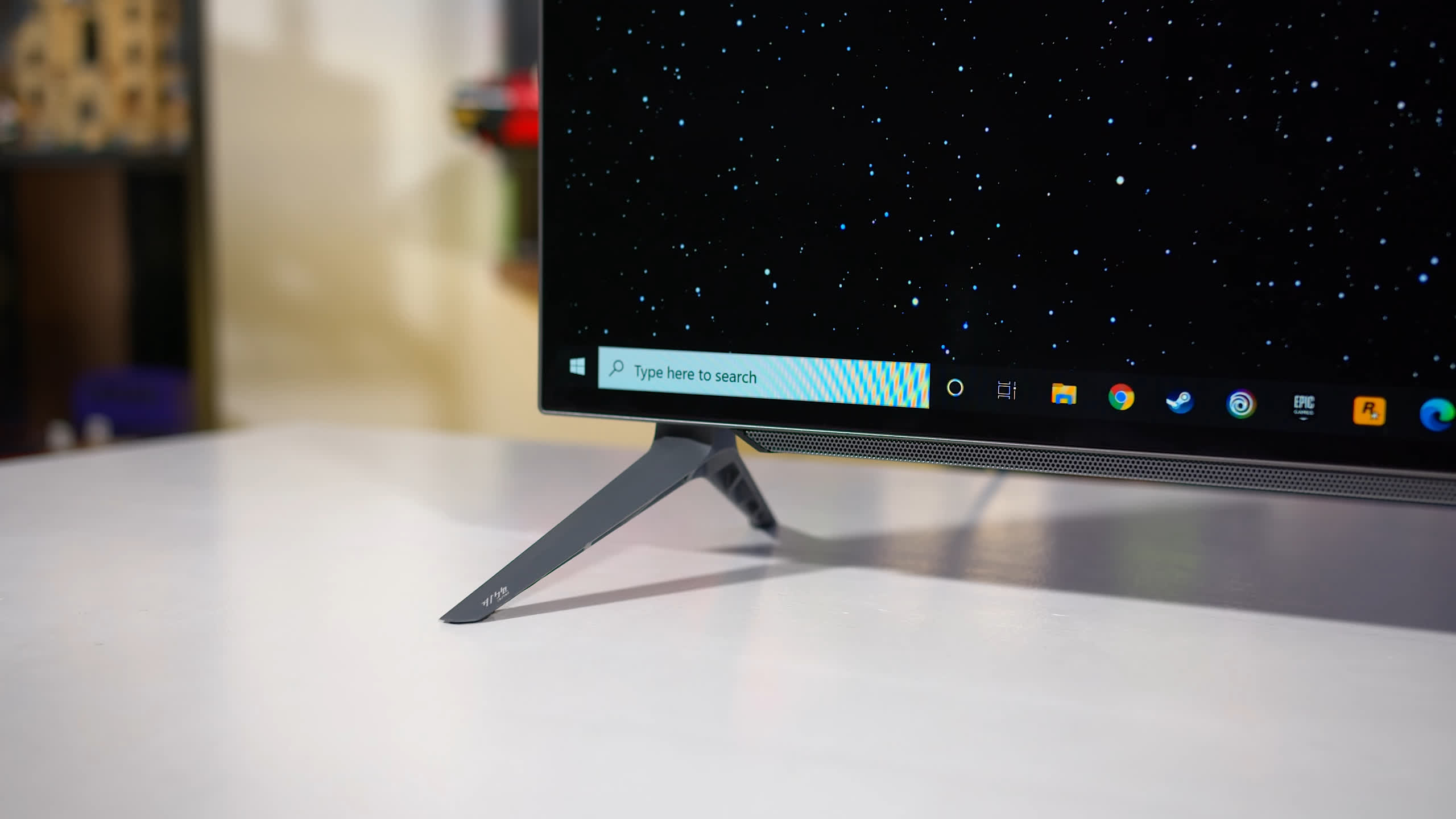
Running along the bottom is a speaker array, which looks fine and are the alkalic sort of TV speakers you normally expect to encounter (and should probably only Be a substitute audio source). There is a directional toggle for controlling the OSD along the bottom edge, and Gigabyte also includes a standard IR remote control (that looks a lot like a Fire TV remote) if you're using the FO48U more like a TV.
In front getting into the carrying into action section of the review, it's remarkable to bring up some of the things we talked about in our LG C1 review happening what it's like to use a 48-inch OLED as a monitor. This is huge monitor and information technology does require a too large desk. The FO48U is 25 cm wider than a 34-in ultrawide at 107 cm wide, and 68 curium tall, thus at normal desk viewing distances it seems massive and might be larger than your field. You'll want to sit back farther than normal to use IT. I'd advocate at least a 1 meter/3 feet viewing distance, whereas for other monitors 60 to 70 cm is more appropriate.
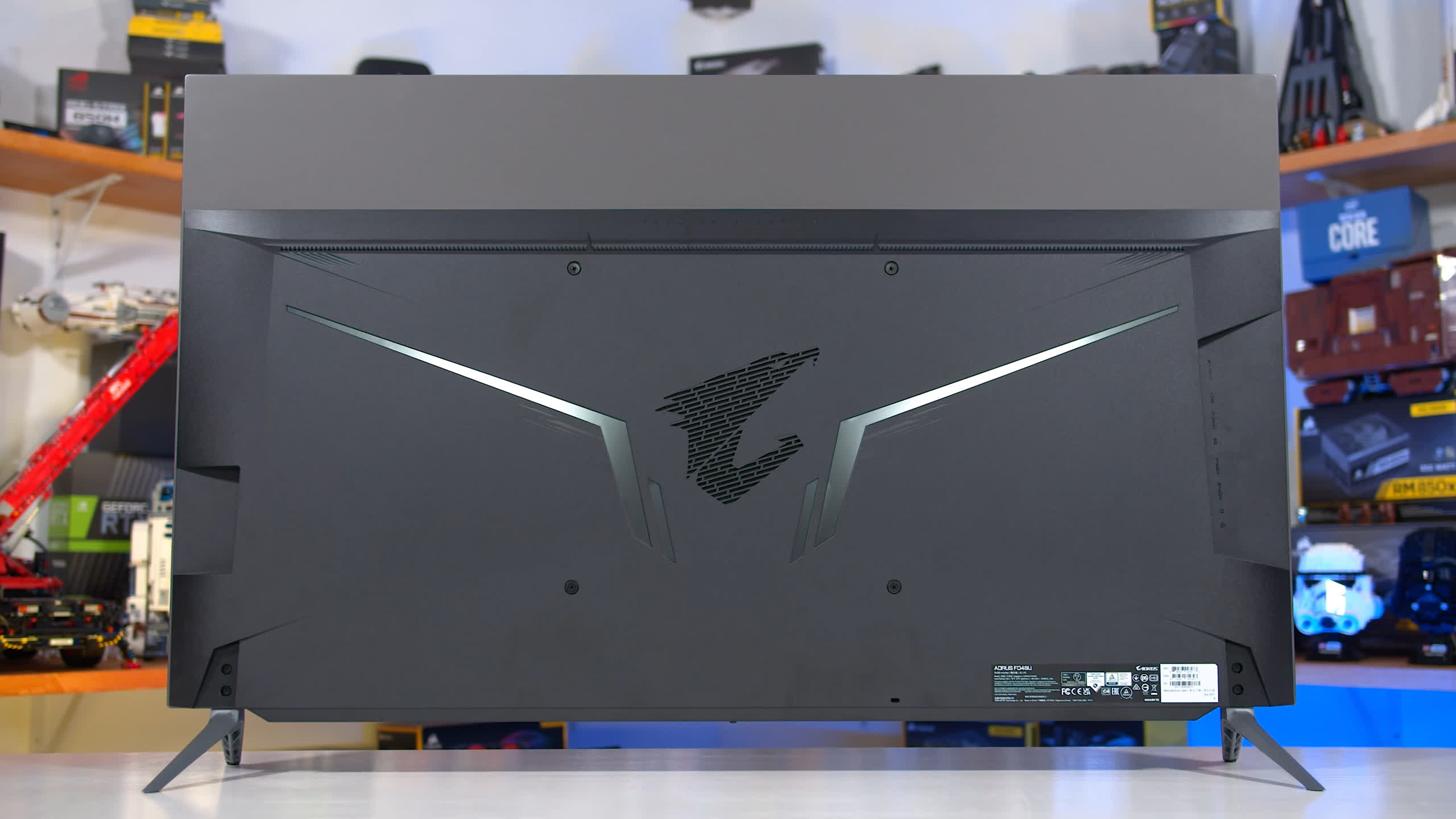
Pixel compactness is the aforementioned as you get on a 32-edge 1440p monitor, which is fine and gives you a lot of cover material estate. However the RGBW pixel layout does touch on text clarity for background use. At 100% resolution scaling it's non as lancinating as a orthodox RGB panel (like a normal IPS varan), even after a eat up Windows' ClearType utility. This display is non designed for fine-text version in desktop applications but it's more of a content usance monitor.
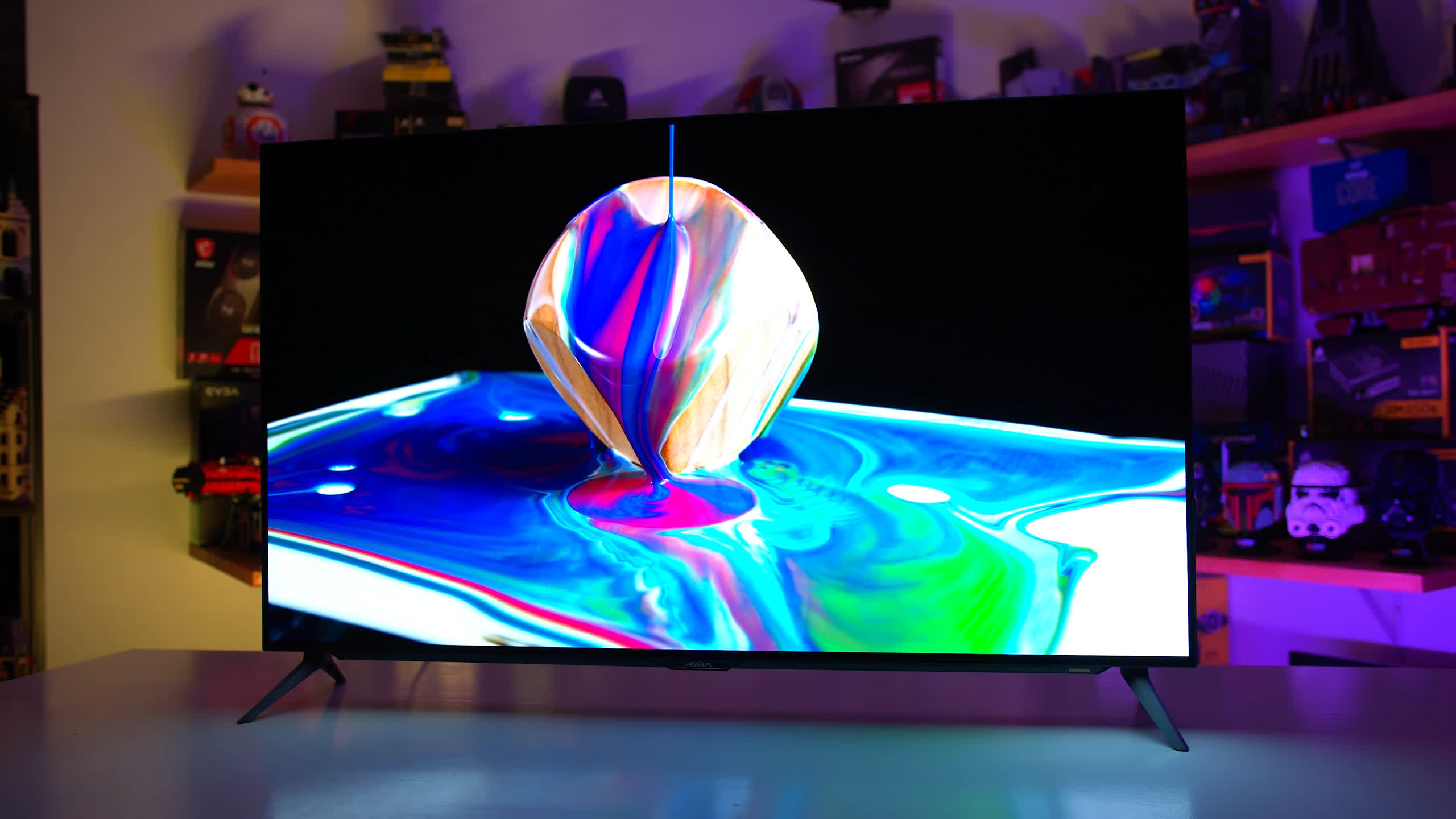
The panel uses a glossy finish with an opposing-reflection coating, which does deliver accumulated clearness and a "rio" factor that you only get with glossy finishes. I believe this generally looks great in darker environments, but in rooms with a Lot of back lighting, the finishing is less effective than the more flat anti-glare coat you get on other monitors.
The Aorus FO48U is much more likely to reproduce clear, defined, mirror-like reflections rather than the less patent diffuse reflections from opposed-glare monitors. LG's opposed-reflection coating used with their OLED panels is one of the outdo as off the beaten track as slip low happening the possible reflections from a glossy finish, but it withal wasn't enough to fully alleviate the issue in my brightly lit office, especially with the frown brightness of an OLED display.
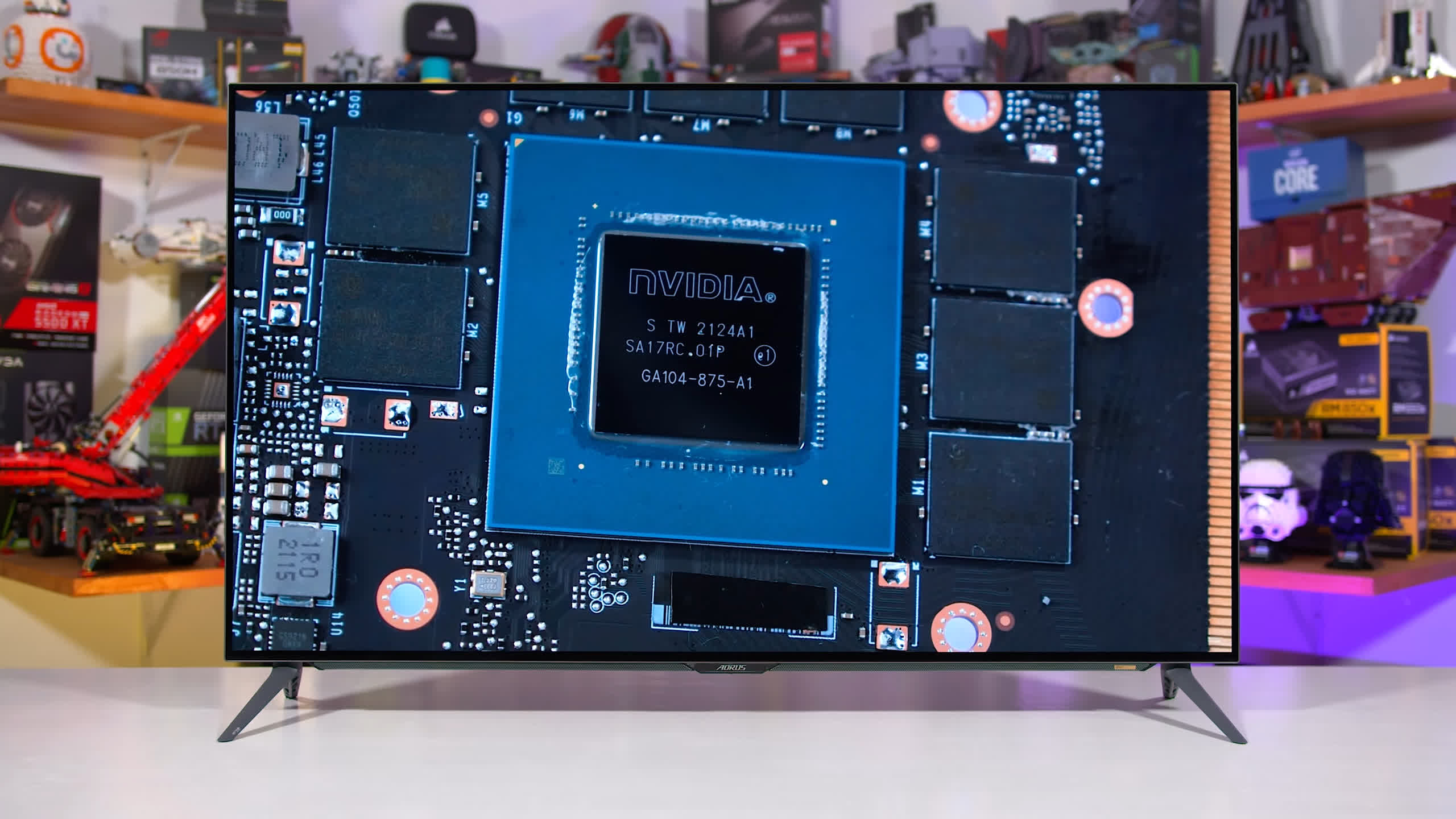
In that respect's as wel the serious run a risk of everlasting cauterize-in with an OLED panel, especially if you plan on using this display equally a desktop monitor where thither leave glucinium lots of nonmoving content. Linus new did a video explaining his experience with an OLED as a desktop productivity monitor where he experienced burn-in rather rapidly, so I would be restrained of using the FO48U that mode. Linus did present what I feel is a worst case scenario for OLEDs and his specific use case was highly at risk of exposure for burn-in -- more so than with typical employment -- only there's to be sure that OLEDs are at risk patc LCD monitors are not.
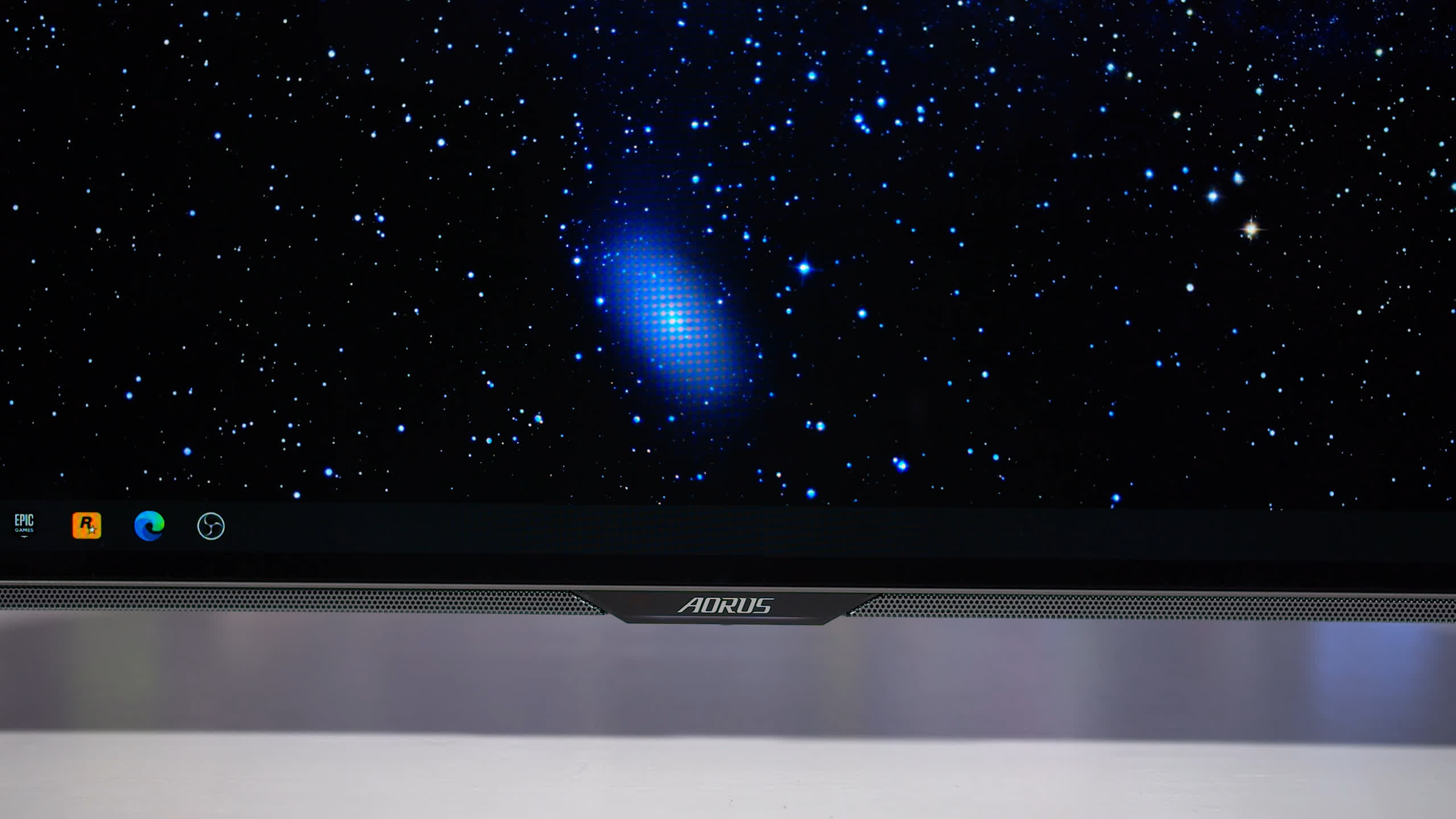
The Aorus FO48U doesn't give quite as many burn in protection features every bit the LG C1. The C1 has automatic logo dimming and pixel shifting capabilities. In real time, pixel shifting isn't great for background use, but it's not included the least bit along the GB model.
GB does implement automatic dimming after periods of inactivity, eventually culminating in a integral screensaver after 15 minutes, though this only applies when the content on screen doesn't change at whol. This is handy when you're away from your PC, just North Korean won't necessarily save it for actual exercise with undynamic desktop apps. Happening a empiricist philosophy note, Gigabyte does include automatic pel refreshers care the LG.
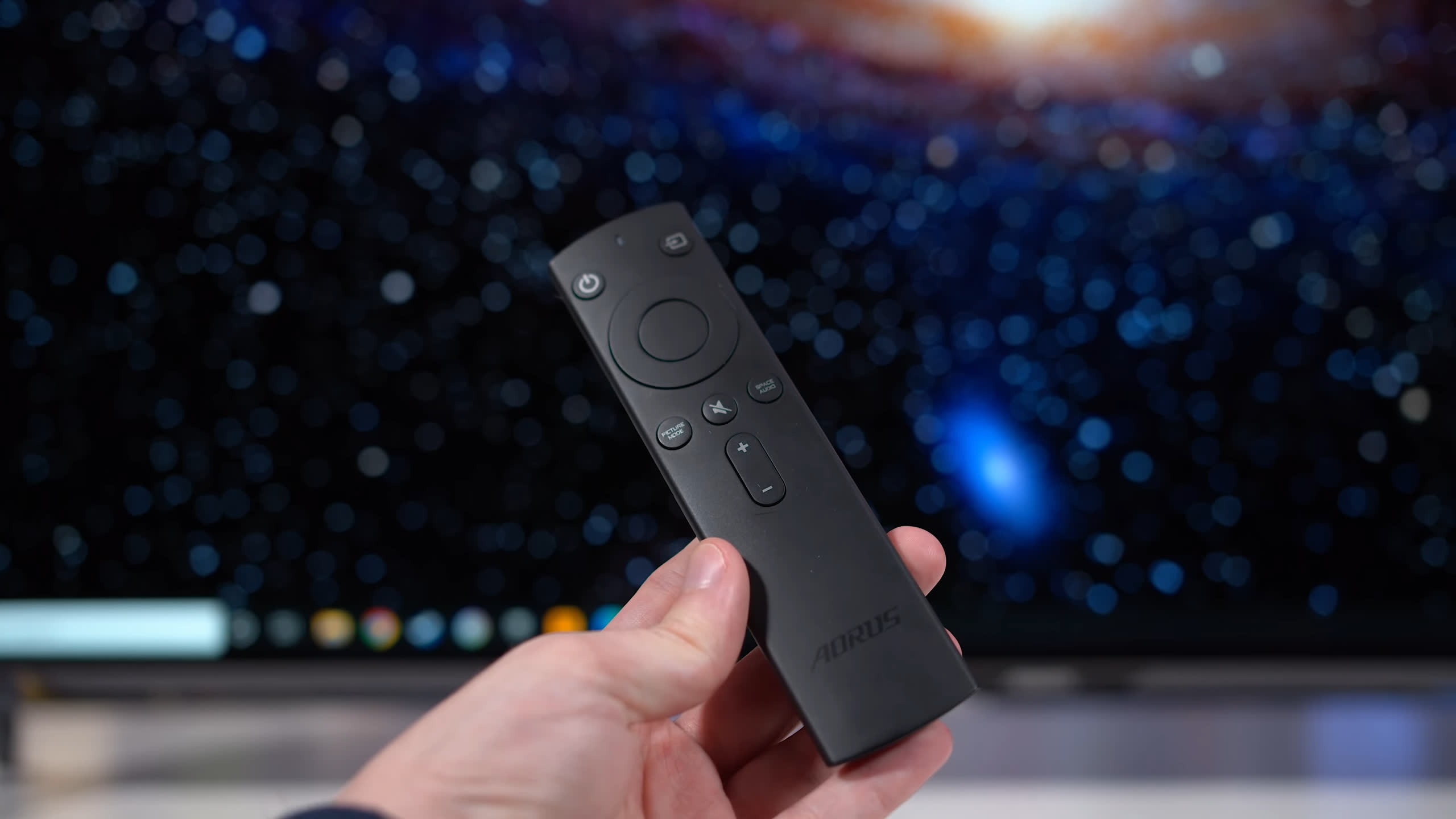
Spell this every might level-headed a act scary, my personal experience using OLEDs over the last few years -- my main Television is an LG Organic light-emitting diode -- suggests that suntan-in is unlikely if you're using the display for content consumption and gaming, evening after several years. My Television has nary burn-in even though I watch a batch of sports happening it with static logos. This is generally what other people have experienced, to a fault, with the stylish panels. However I would urge against buying the FO48U for heavy all-sidereal day desktop productivity use, a little of desktop use mixed in with gaming and video playback isn't going to be a monolithic government issue, but lots of atmospherics content is an issue and something to exist mindful of.
Display Carrying into action
In terms of reaction time performance, because the FO48U is an Organic light-emitting diode panel, information technology's extremely fast and doesn't require overuse settings. The automatic brightness clipper did lay down IT a bit more difficult than usual to gather these numbers just we establish a suitable workaround that's very accurate, which was basically to make the run window small.

Intrinsically what you'll see here at 120Hz are results very similar to the LG C1 OLED, therein the norm latency is around 1.5ms using our strict test methodology, with zero appreciable overshoot, and laughably good cumulative divagation of below 100, which indicates come near instant reply behaviour.


This behavior is held at lower freshen up rates, so whether you'rhenium running game the display at a geostationary 120Hz, fixed 60Hz, or with adaptative sync variable refresh rates, public presentation is always excellent and so the reminder has a various overuse mood have. Easily… it would have one anyway as there's no overdrive modes, but you know what I have in mind, performance is corking across the freshen up compass and wondrous for PC gaming.

Compared to other monitors, the FO48U destroys LCD panels under the second-best conditions. Public presentation is selfsame similar to the LG C1 so you're not wanting proscribed there the least bit, while overall answer times are several times better than even the best LCD monitors. The question clarity as a result is unique and this is unitary of the major reasons to fix an OLED or else of an LCD.

It gets better looking at average performance across the refresh range, where the FO48U is even promote ahead of the Liquid crystal display pack. Non only is go-around completely negligible along intermediate, response multiplication are outstanding, so at whatsoever freshen rate you sack be sure motility performance is as good as you can begin.

But it's not just about reply multiplication, accumulative digression is also important to getting an musical theme how fast the FO48U and OLED panels are. These displays aren't just fast, simply they are fast over the huge majority of the changeover with very little lingering hold at either cease. This leads to exceptionally good cumulative deviation, as the transition behavior is very close to the ideal instant square-adjoin response. LCD panels are laughable in comparability as seen in the huge delta between them and the top of the postpone OLEDs.


120Hz execution is excellent either for Personal computer gaming or use with current generation consoles. Nary early display I've tested comes penny-pinching to the motion carrying out on offer here at the same refresh charge per unit. Information technology's connatural at 60Hz, though response behavior is limited by the refresh rate itself, which causes motion blur inherently with a sample and cargo area display. However this is clearly American Samoa moral as it gets from mod displays at 60Hz.

Stimulus dawdle is a non issue with the FO48U, forthcoming in at under 1ms of processing delay, and a tote up retard in the chain combining weight to 240Hz monitors ascribable its extremely fast modulation times. This means that while the FO48U doesn't feel as smooth equally a 240Hz monitor as you are only seeing half the amount of refreshes, the actual delay to getting the image into your eyeballs is just as fast. However the FO48U has no inherent delay advantage over the LG C1, which in its PC configuration also has very low stimulant put away, so removing all those TV features hasn't given GB any wooden leg heavenward.

Power consumption is selfsame high, typically threefold that of an LCD collect to its size. And that's at a lower luminosity as well, as the FO48U can't actually hit 200 nits for a full screen whitened window that we exam with for power consumption. IT's actually dimmer than the LG C1 as we'll show later in this review, which causes the variance between the Gigabyte and LG models. But basically OLED is not as underspent of a engineering as LCD for displaying bright images, sol power white plague is high.
The FO48U does support backlight strobing, or in that case black frame insertion every bit the Organic light-emitting diode panel doesn't technically feature a backlight. Unfortunately it doesn't work with adaptive synchronize simultaneously; the Aim Stabilizer feature is only accessible at fixed refresh rates, though both 120Hz and 60Hz operation is suspended.
While the 120Hz mode is very similar visually to the LG C1's OLED Motion Pro feature, in that it delivers perfect strobing with an extremely clear envision, there's an issue with the 60Hz implementation. At 60Hz, it looks like the FO48U is double strobing which causes ii images on the screen at the same time. This is ugly and looks bad, so the LG random variable has the superior backlight strobing effectuation as it's really usable at 60Hz.
Color Functioning
Color Space: GB Aorus FO48U - D65-P3

Color performance is generally really good from the FO48U and other OLEDs based on LG's panels. The expose is wide-eyed gamut and optimized for P3, with a very piping 97% coverage of that gamut in our examination. However it's not As wide as the best LCD panels of today, which volunteer full Adobe brick RGB reporting likewise. The FO48U covers to a lesser extent than 90% of Adobe RGB, leading to a total Rec. 2020 reportage of 70% - that's a good result, only not the best I've seen, though still enough for HDR use.
Default Color Performance



One of the main issues with the LG C1 was terrible proscribed of the box calibration, particularly for greyscale. That's fewer of an issue with the Gigabyte model. The nonremittal mode International Relations and Security Network't perfect and both the gamma and color temperature charts are a little wonky for sRGB usage, leading to only mid-range deltaEs -- but this is miles better than how the C1 comes configured.


Unfortunately spell the C1 defaults to an sRGB color space for SDR exercis, the FO48U does not, so colours are oversaturated unsuccessful of the box, even with the color space mode set to "auto". This is more succeeding with typical monitor performance, though it's not accurate and the way the LG OLED handles things is better. This isn't the end of the world only when you check performance up against other displays the FO48U is only mid table in both of our tests, in fact greyscale performance could probably do with more optimization.



Thereupon said, the FO48U does attach to an sRGB manner, which improves carrying out importantly. Greyscale performance is more accurate to the sRGB gamma slew, although it did adjust color temperature negatively and this can't equal changed -- once once again information technology's mute that some displays don't allow white item alteration in their sRGB mode. However it does efficaciously clamp the gamut so overall deltaE performance is pretty good and this mode in the main is very usable for diarrhetic SDR content.
Calibrated Color Operation
When it comes to calibrating the FO48U, this display Acts of the Apostles mostly like a monitor, so it really lacks the advanced standardisation features of the LG C1. The C1 gives you much greater control over white point and greyscale fitting, and you can tweak all sorts of values straight in the hardware, so you don't need to depend on ICC profiles. As a matter of fact you lavatory even use exceptional paid software like Calman for LG to enhance the calibration further. None of this is available with the FO48U, so its calibration options are much weaker.





You can achieve great results with a calibration pass in Portrait Display's Calman computer software, but we're speaking about a pure software solution that relies on Interstate Commerce Commission profiles and app compatibility. Then while the results are clean, the FO48U suffers from inferior robust hardware calibration support.

Vertex brightness from a full white window is awful, and remains the major issue with OLED technology and wherefore I wouldn't recommend using this display for screen background usage. Not only is the FO48U dimmer than the C1 for untasted white images -- which affects background apps -- it besides has a more aggressive automatic brightness limiter. The ABL feature means that the FO48U increases exhibit brightness when the content connected the screen has a get down average picture level, in other run-in, if in that respect's more black operating theatre coloured areas on the screen, the brighter white areas will become. This is most noticeable when resizing app windows along the desktop, if you hit a bright browser window large, luminousness will bead, and frailty versa.
In that location too appears to be no way to get around this. On the LG C1, you could either pee-pee the display even dimmer, which tended to stop the ABL from activating, or use the service fare to disable the feature in some microcode versions. The FO48U's ABL is always active and more noticeable in apply. I get into't think this is a big deal for content consumption arsenic it's not that available in videos or games, but when using this display A a desktop monitor it's annoying.
Minimum brightness is unbelievable though, this is non a joke, when the luminosity is set to 0, the display tops out at 1 nit. I'm non sure how useful that is in practice, but that's very dim.

Contrast is infinite with the FO48U American Samoa the OLED venire is self lit, so each individual pixel has the capability to fully tack off to display black. This is far superior to any LCD monitor I've tried, and black levels are even darker than the best VA LCD panels. The lustrous jury helps accentuate this in most viewing environments, star to prominent visuals. It's also one reason why OLEDs can get away with lower peak brightness for content consumption, American Samoa the deep blacks still produce a towering contrast experience that your eye can conform nicely to.


Showing angles are superb and I find the FO48U and otherwise OLEDs to follow extremely viewable even at crazy angles. Uniformity was also very solid with my unit. At times OLEDs can be a bit iffy with uniformity but my FO48U was in reality better than my C1 in this regard leading to strong results.
One of the big selling points to buying an OLED like this is the HDR see. The FO48U offers a true HDR demonstration, striking all starring criteria, including the big unitary in contrast. As I've been talking about, someone-lit panels are open of incredible contrast ratios, which is the entire welfare to HDR and why Organic light-emitting diode is especially well suited to HDR -- at least in contrast to virtually of today's LCD monitors.


In real world HDR content, whether that's games or videos, the FO48U has no blooming equal you would see with an LCD with full array local dimming. Bright and benighted areas can peacefully coexist on the screen simultaneously with no crossover, directive to dead stunning HDR visuals. Combined with deep blacks and a lot of deepness to shadow detail, I think the FO48U looks large in nigh HDR content.


But the one orbit where this display suffers is once again in brightness. OLEDs do compensate for this to whatsoever degree by their nil black levels, but a full cover white image topping outgoing at 123 nits can only take you so far. This pales in comparison to the best LCD monitors of today. There's also really no electrical capacity for this display to produce a bright full cover flash for something ilk an explosion, which is disappointing.

The main issue with the FO48U's HDR performance is small windowpane brightness. The LG C1 does bad well here, reaching 775 nits which means that bright highlights on the screen are authentically quite bright. The FO48U doesn't fare nearly too in its default HDR mode, only reaching 555 nits. Yea this is better than SDR performance, but it's hardly impressive and well behind the C1 that uses the same control panel.
The FO48U does let in an "HDR Vivid" modal value which increases brightness in the same test and gets nearer to what the C1 fanny do, but it completely destroys truth. Darker tones are too bright in that mode, and the white point is strongly tinted blue, so it seems this mode is trying to cheat a high pressure brightness level for the sake of examination. We harbour't used this mode in our charts for that intellect as it doesn't look good in practice. In substantial macrocosm usage the FO48U is dimmer than the LG C1 and that's just the reality of it.

Brightness vs window size is a little better for the FO48U, which performs likewise to the C1 down to a windowpane size up of 25%, and eventually closes the gap at littler windowpane sizes like 2%. Fundamentally though, HDR brightness is on the weaker final stage of the scale and while I still think it looks capital for HDR in world-wide, it's not as great equally the LG C1.
Obviously the main advantage here though is the contrast ratio. While LCDs top out at roughly 12000:1 in our worst type single frame contrast tests, OLEDs are still capable of infinite contrast so they looking far better and don't brook from blooming issues.


HDR accuracy is acceptable, the FO48U is a itsy-bitsy happy when displaying darker tones and the aggressive roll-off can hurt the level of detail in bright scenes as the roller-polish off point is quite future in the EOTF curve. But overall it's not regrettable. Then for color tracking, results are okey as well, this display isn't unnecessarily oversaturating colors in the HDR manner which is a in effect affair for the visual presentation.
Hot Beaver State Non?
Overall, the Gigabyte Aorus FO48U is one of those displays where if you had it in isolation and you didn't compare it to umteen other products, we think you'd be very happy with information technology. There is zero questioning it looks excellent when displaying self-complacent, whether that's movies or games in either its HDR or SDR modes, and that's every down to the use of Organic light-emitting diode.
Blacks are deep, contrast is infinite, and response times are lightning fast, to the show where it embarrasses LCD panels in motion clarity.
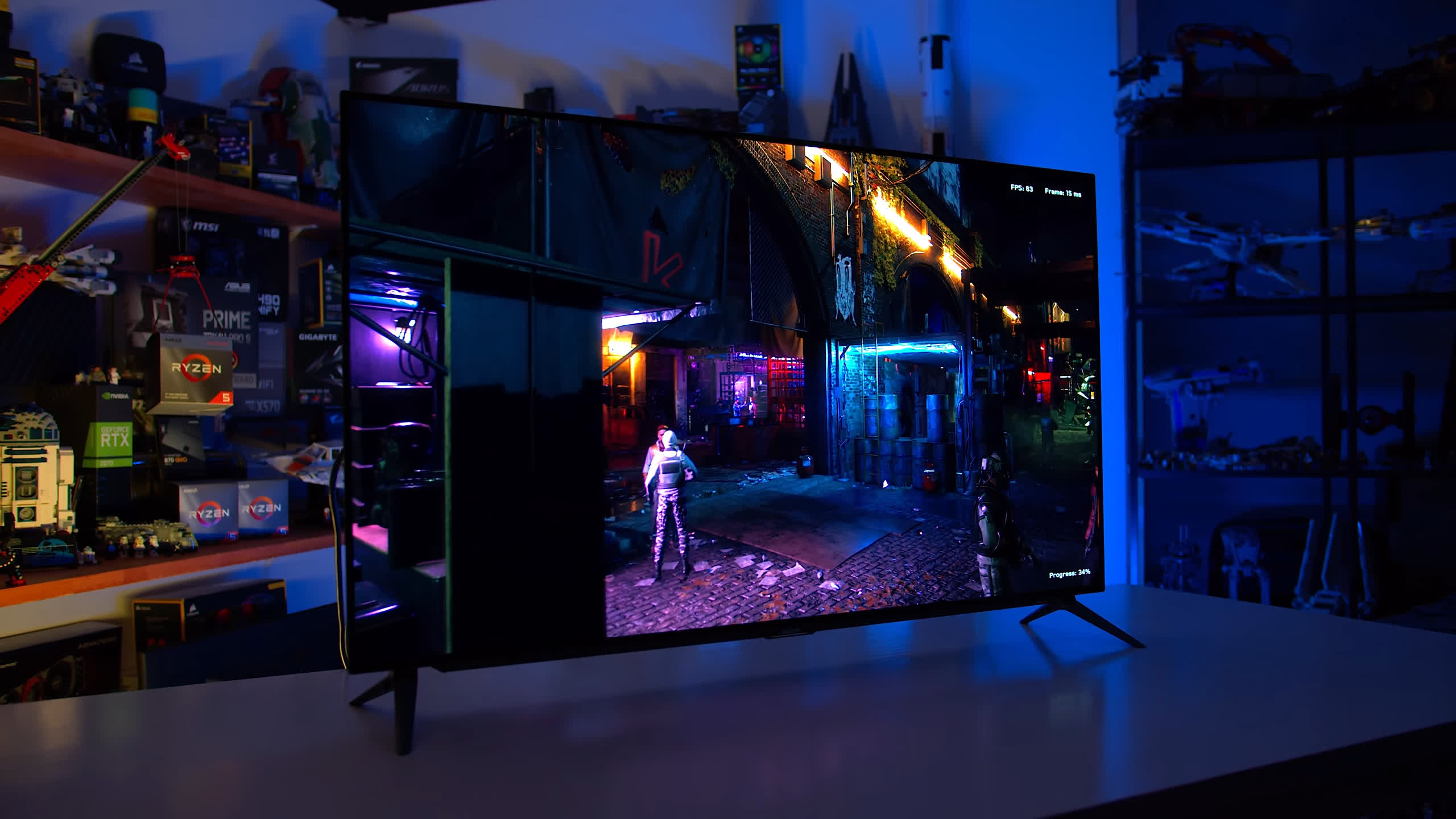
Unfortunately for GB though, the Aorus FO48U isn't arsenic good as LG's C1 OLED that we reviewed earlier. Contempt both using in essence the assonant LG OLED control panel or a close variation of it, the C1 has more features with better performance in some key areas. On the flip side, Gigabyte don't have umteen incomparable features of their own that are worth caring just about.
While the FO48U is essentially the same as the C1 in areas comparable reply times, contrast and color gamut, the C1 is noticeably brighter in HDR content, to the tune of 100-200 nits brighter. That's a extensive deal on an OLED panel where brightness is less than amazing. And sure, both panels have poor full screen empty brightness that makes desktop use to a lesser extent than stellar, but in the HDR mode the C1 looks finer.
The LG C1 also has a less aggressive auto-brightness limiter, though both panels are still disagreeable in how brightness changes contingent the content.

The LG C1 is a far more feature full display. It comes with four full bandwidth HDMI 2.1 ports (versus two 24 Gbps ports on the Gigabyte), it has a full align of Boob tube functionality including smart TV apps, a TV tuner, AI upscaling, denoising and more. IT supports Dolby Vision where the FO48U alone supports HDR10 and HLG. Information technology has a overmuch finer range of hardware calibration features. It has a wagerer black anatomy insertion mode. And then on top of that, information technology's got a comely readiness of features to make it compatible with PCs and gaming setups, including a low latency mode, allowing it to match some other gaming monitors.
The Aorus FO48U counters that with a DisplayPort connector, a KVM throw, and some gaming-specific OSD features. That's not anyplace near enough to constitute for the big list of omissions. For example, we'd rate Dolby Vision support as right more important than having DisplayPort. The reality for Gigabyte is they are competing against a Telecasting giant that has well-mannered their offering for gamers over single iterations in real time. Thus first appearance a first-gen OLED offering with operative feature omissions International Relations and Security Network't expiration to cut it.
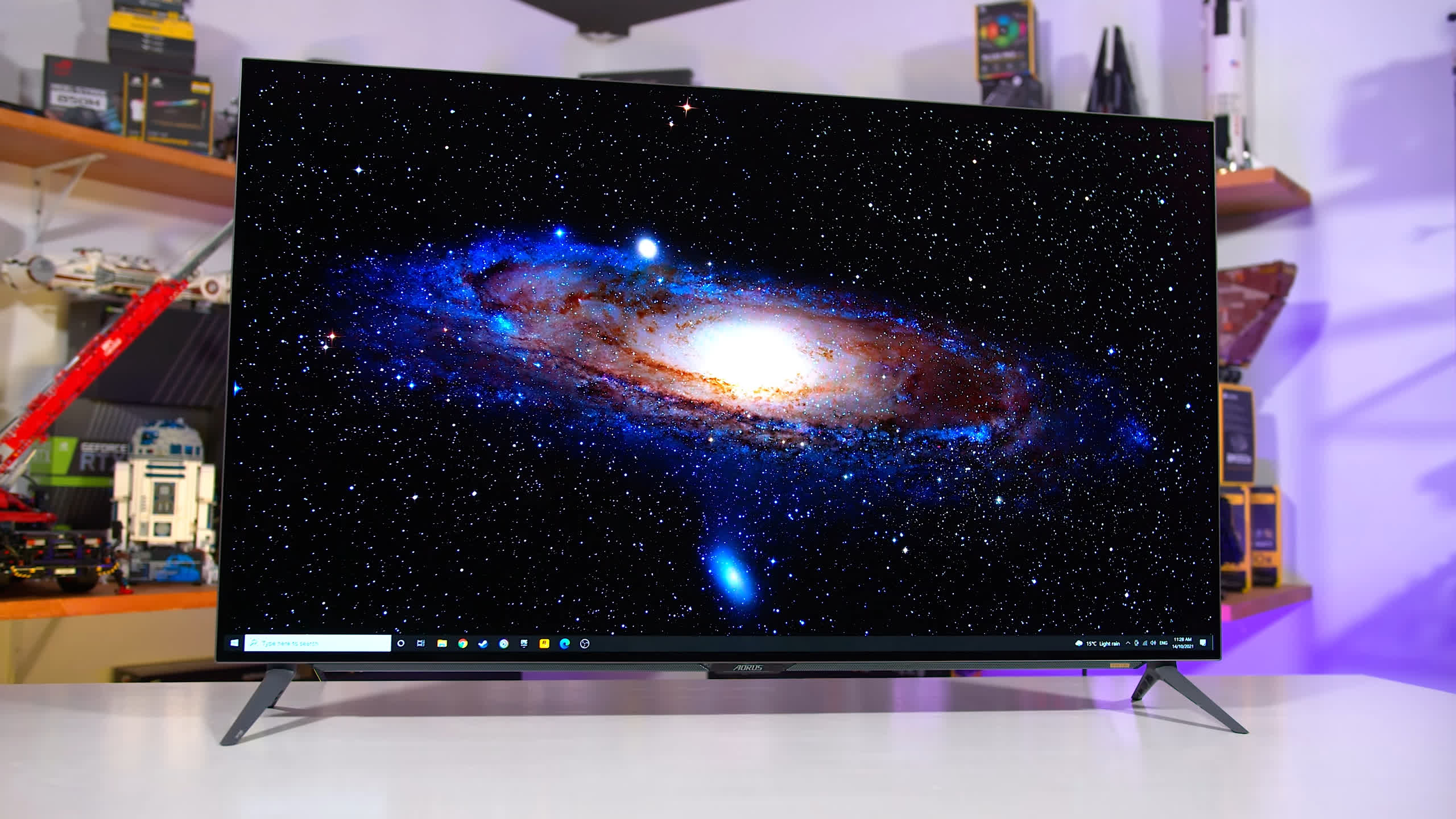
Of course, this can be salvaged with a competitive price point: the Aorus FO48U has to be several centred dollars cheaper than the LG C1 to make sense. But that's not the case and the actual delta can differ contingent on the region. In the US, the MSRP of both products is the aforementioned, and often the LG C1 is cheaper attributable discounts and promo pricing. In Australia, the retail Leontyne Price is to a lesser degree the LG mock up, only the C1 frequently receives discounts to nullify that spread. This makes it hard to commend the Gigabyte model even though it's far from a poor performing artist.
Shopping Shortcuts:
- Gigabyte Aorus FO48U on Amazon
- LG C1 48" Organic light-emitting diode TV on Amazon
- LG 110 48" OLED TV happening Virago
- Asus ROG Dean Swift PG32UQX on Amazon River
- Samsung Odyssey Modern G9 happening Amazon
- Samsung Odyssey G7 32" along Amazon
- Horsepower Omen X 27 on Horsepower Store
Source: https://www.techspot.com/review/2345-gigabyte-aorus-fo48u-oled/
Posted by: grahamthein2000.blogspot.com


0 Response to "Gigabyte Aorus FO48U 48" 4K OLED Review - grahamthein2000"
Post a Comment